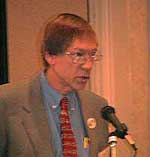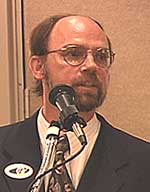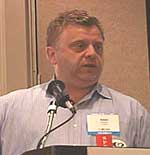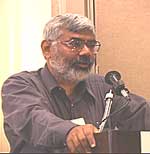Calit2 Researchers Brief San Diego Biotechnology Executives on Bioinformatics
Calit² Researchers Brief San Diego Biotechnology Executives on Bioinformatics
|
On July 17, the deputy leader of Calit²'s layer on digitally enabled genomic medicine (DEGeM), Peter Arzberger, told an audience of more than 220 executives from San Diego's biotech industry that the institute is committed to research on bioinformatics and bioengineering research. "Some of you may have thought that all the bioinformatics work would be done by the sister institute of Calit² based up north [at UCSF], but that is not true," said Arzberger, who is also director of Life Science Initiatives at UCSD. "The technologies of telecommunications and information technology are driven by applications that shape where we're going, and bioinformatics is an inherently multi-disciplinary area where we are putting great emphasis."
In 2001, UCSD formally instituted a graduate program in bioinformatics, and the Jacobs School of Engineering's bioengineering department is ranked #3 in the nation, according to U.S. News & World Report.
Arzberger moderated a morning panel on "Bioinformatics: Breakthroughs in San Diego," for BIOCOM/san diego, the region's premier trade association representing more than 180 companies in the life science industry. The meeting showcased the work of Arzberger and three other UCSD researchers who participate in Calit²'s DEGeM activities: Shankar Subramaniam and Andrew McCulloch of the Jacobs School of Engineering, and Adam Godzik of the Burnham Institute and the San Diego Supercomputer Center (SDSC).
In his opening remarks, Arzberger reassured the audience that although Calit² is nominally focused on telecom and information technology, both areas overlap with the life sciences. He noted that with sensors built into a high-tech, wireless prototype of a "smart Band-Aid", the human body can become an Internet data source. Doctors will be able to track their patients' vital signs from any Web device, 24 hours a day, and Arzberger said that powerful data-mining techniques under development at UCSD, combined with body sensors and knowledge of an individual's genomic code, will pave the way for "genomic individualized medicine."
|
"Integrated Computational Biology of the Heart" was the topic of Andrew McCulloch's presentation. A professor of bioengineering who is also associated with the Whitaker Institute of Biomedical Engineering, McCulloch talked about integrative computational modeling to further understanding of structure and function, and correlate data and theory. McCulloch has developed a computational model of the heart (see graphic) that ties in silico with in vivo inputs and outputs to apply the model to medicine. He also talked about the advantages of using computer modeling with cardiac imaging to enhance patient outcomes. "In collaboration with Harvard Medical School, we have a new program funded by the NIH on computer-assisted surgery and surgical planning using our model of the atria, for developing robot-assisted cardiac surgeries that don't require bypass," said McCulloch. "These tools will also have an impact on drug discovery, and one New Jersey company, Physiome Sciences, is already using it for that purpose." McCulloch has also co-founded a company called Insilicomed, a computational biology startup that develops in silico models for biomedical engineering design and drug discovery.
|
Adam Godzik spoke about the "Structural Catalog of the Human Genome-from Genes to Structures to Functions." The Polish-born Godzik directs the Bioinformatics Core of the Joint Center for Structural Genomics at UCSD. He noted that structural genomics is an exercise in massive data collection and analysis. "Sequencing of the human genome was only the beginning and there is much information we still need to make that sequencing useful," said Godzik. "Of all the information missing, the three-dimensional protein structure has a unique role. The reason is that all events in cells happen at the molecular level. So if you look at every interaction point, there are two proteins interacting with each other at the molecular level, so if something goes wrong, or if a drug is working, it's happening at this level." Godzik also noted that 70% of the human genome cannot be analyzed by using 3D structures to understand function at the molecular level.
|
Bioengineering professor Shankar Subramaniam, who is also on the Chemistry and Biology faculties at UCSD, titled his presentation "Bioinformatics: Is the Post-Genome Sequence Era a Harbinger for Systems Biology?" His short answer: yes. "One of the things that has revolutionized life science is the ability to integrate information, the ability to mine data, the ability to piece together large volumes of data and compute on them," said Subramaniam. "San Diego has played a significant role in this, and Calit² has the potential to provide the ability to take all this combined revolution at the interface [see graphic] of biology, engineering and information technology into an integrated whole." Subramaniam is in charge of UCSD's new (July 2001) Graduate Program in Bioinformatics, a collaboration of seven different graduate departments. He also participates in the Alliance for Cellular Signaling, which Subramaniam said, is focused on "determining the quantitative relationships between inputs and outputs that vary temporally and spatially."





